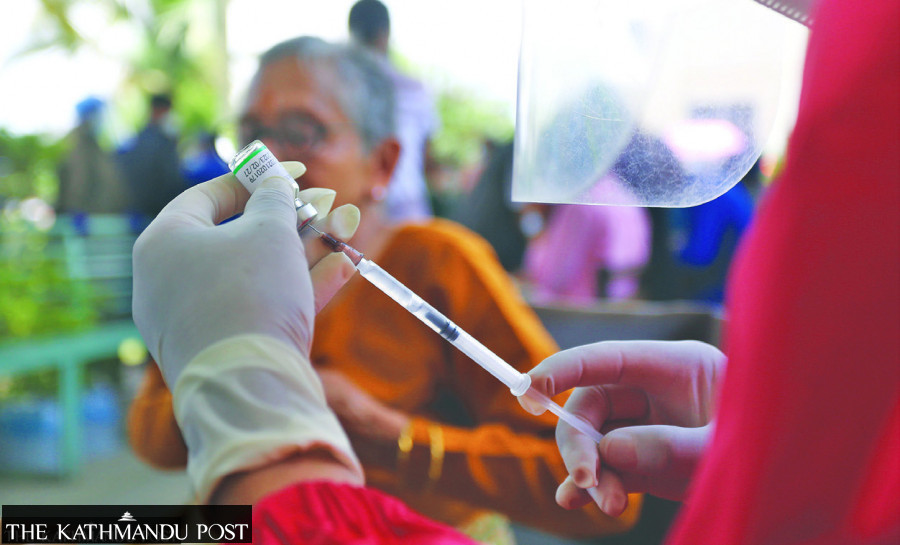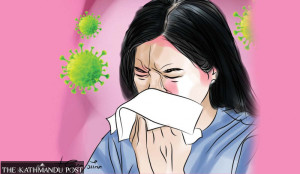Health
Authorities have no details on the tens of thousands of unjabbed people over 65
Lack of proper record keeping and mismanagement could derail the plan to vaccinate all by mid-April, experts say.
Arjun Poudel
Around 40 percent of people aged 65 and above who took the first dose of the Covishield vaccine in March have not taken their second dose yet, according to Kathmandu Health Office.
When the people of the said age group did not seek the second dose after receiving the first dose between March 7 and 15, authorities administered the newly arrived AstraZeneca doses to people of other age groups as well as college students.
“We did not want the vaccines to expire, so the only way was to administer the doses to others,” said Badri Bahadur Khadka, the chief of the Health Office, Kathmandu.
Authorities started administering second doses of the AstraZeneca vaccine to the people aged 65 and above from the first week of August, after the jabs arrived from Bhutan and then Japan. Bhutan had supplied 230,000 doses on August 6 while Japan shipped over 1.6 million doses in four tranches from August 8 to August 23.
Officials at the Ministry of Health and Population said that they do not have detailed reports but admitted that the number of people who missed the second dose of the AstraZeneca vaccine is “huge”.
“I don’t have the exact number right now but the number is significant,” Dr Jhalak Gautam, former chief of the National Immunisation Programme, told the Post.
What is more concerning is that authorities are unaware of the whereabouts of the hundreds of thousands of people aged 65 and above, who have not yet taken their first doses.
Of the around 1.8 million people aged 65 and above across the country, over 1.4 million people were administered the first dose of Covishield, the AstraZeneca type vaccine manufactured by the Serum Institute of India. The estimation of the number of people above 65 was made on the basis of a report of the Central Bureau of Statistics.
For those who took their first dose of Covishield, the wait was quite long—about five months—before they could get their second doses, as the vaccine supply had dried up.
In the meantime, doses of the Vero Cell vaccine received from China were administered to various age groups. But there is no data on how many people of which age groups were administered Vero Cell.
The government last week said it had administered more than 10 million doses of vaccines against Covid-19, but authorities do not have the exact age-wise and vaccine-wise data.
If the number of frontline workers, including health workers, sanitation workers, prisoners, journalists, administrators and teachers, among others, are counted alongside those who took their first dose of Covishield between March 7 and 15, the number of people aged 65 and above who took their first dose during that period could be even less.
“We don’t know the whereabouts of those people who have not yet taken the first dose of vaccine,” said Gautam, “The vaccines were administered from all 77 districts. We don’t have any system to track who has taken the vaccine and who has missed out.”
The government provides each individual a vaccine card, which mentions the name, age, the type of vaccine and the date of administration. People have to produce the same card when they go for their second shot. The government, however, has not maintained any data entry system, hence there is no digital archive of the people who were vaccinated.
Gautam said that a lot of people might have missed their second dose because they could have misplaced their vaccine cards. And some people may have taken their second dose in India, officials presume.
As soon as Nepal received 1 million doses of Covishield from India under grant assistance on January 21, the government had created priority groups to vaccinate against Covid-19. Then Nepal in February received an additional consignment of Covishield, for which the government had paid. Authorities decided to administer the vaccine to people aged 65 and above between March 7 and 15, with a view to preventing severe illness and mortality due to the coronavirus among the people of this age group.
Mortality rate among people above 65 years was above 60 percent during the first Covid-19 wave.
Cases have declined in Nepal after the devastating second wave struck the country in April this year. But with the Delta variant circulating, experts are predicting the third wave, and amid this a larger number of the elderly–many unvaccinated and others without the second dose–could be exposed to more risks.
“Over 400,000 people above 65 years of age are still unvaccinated, and this is not a small number,” said Dr Shyam Raj Upreti, coordinator of the Covid-19 Vaccine Advisory Committee. “Authorities have neither tried to trace them nor are they aware of their vaccination status.”
Nepal initially aimed to vaccinate 72 percent of its 30 million population, or around 22 million people, as there were no plans to inoculate those aged 14 and below. To vaccinate the targeted number of people, the government needed to arrange over 45 million doses of a double-shot vaccine.
Nepal so far has used two types of double-shot vaccines (AstraZeneca and Vero Cell), and one single-shot type (Janssen produced by Johnson & Johnson).
Nepal so far has received a total of 13,357,590 doses of vaccines. Of them, 4,422,740 doses are AstraZeneca, 7,400,000 doses are Vero Cell and 1,534,850 are Janssen.
As of now, 5,533,794 people (over 18.4 percent) have taken the first dose and 4,895,152 people (over 16.3 percent) have been fully vaccinated.
“It does not look like the authorities are concerned about vaccinating the elderly. There are many who have not even taken their first dose and this puts them at a higher risk of infection and death,” said an official at the Health Ministry requesting anonymity because he is not authorised to speak to the media. “Why can’t we track the people who have not taken the first dose if we boast about having an extremely good mechanism for child immunisation?”
Public health experts say that tracking people who have not taken their first dose and who have not sought the second should not have been a big deal had authorities shown seriousness from the very beginning.
“We have had this vaccine management issue from day one,” said Dr Sarad Onta, a public health expert. “This problem is not as big as procuring the vaccines. Only if we had made a little extra effort, this problem would not have arisen at all.”
Even though Nepal was among the first countries to launch a Covid-19 vaccination drive, vaccine supply was intermittent, and experts say authorities could have used those windows to plan how they could maintain vaccination records.
Instead, authorities took some ad hoc decisions like making it mandatory for all to fill online forms to get vaccinated, which gave rise to concerns about the digital divide. Experts say it was the authorities’ duty to keep records of the people who were vaccinated, and as the campaigns were run in intervals, there was ample time to maintain the data.
With no proper record-keeping, the government’s plan to inoculate all eligible citizens could fall flat. Since no one is safe until everyone is safe, there is a need to maximise vaccine coverage. The government has announced plans to vaccinate all eligible citizens by mid-April next year. If hundreds of thousands of people fail to get vaccinated, the coronavirus threat will continue.
Officials say the government has also reached deals with companies like Moderna and Pfizer-BioNTech to procure more vaccines.
“Reaching deals with vaccine manufacturing companies is one thing and administering the doses to the target groups is another,” said Upreti, who is also a former director general of the Department of Health Services. “If we ignore the vaccination issues and do not pay attention to the need to track the people who have been left out, our goal of vaccinating all will continue to remain a distant dream.”




 10.12°C Kathmandu
10.12°C Kathmandu












%20(1).jpg&w=300&height=200)

